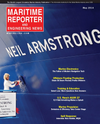
Page 33: of Maritime Reporter Magazine (May 2014)
Marine Electronics Edition
Read this page in Pdf, Flash or Html5 edition of May 2014 Maritime Reporter Magazine
www.marinelink.com 33
American VULKAN Corporation
Ph: 863-324-2424 | [email protected] | www.vulkan.com
Your source for premium power transmission solutions for Marine, Indus- trial and Construction Equipment applications in North America (includ- ing Canada and Mexico), the Caribbean and now countries of Central
America and parts of South America including the nations of Columbia,
Ecuador, Peru and Venezuela.
Photo credit: LCS2
American Vulkan MR Jan14.indd 1 12/19/2013 9:55:54 AM
Elmer A. Sperry “The marine interests may certainly expect great and material aid from this wonderful instrument.
Not only, I predict, will it guide our ships but it will be found to have other important and far-reaching bearing upon the operation of ships at sea.”
Elmer A. Sperry, in prescient comments on Hermann Anschütz-Kaempfe’s gyrocompass, at a meeting of SNAME in 1908. of how he might make the dwellers on earth a little more at ease whether on sea or land or in the air.’’ In fact, his inven- tions, which typically focused on motion and energy, were all about creating, con- trolling, driving or directing movement.
If it moved – whether it needed to be stabilized, navigated or powered, Sperry was on it. He even produced some of the earliest versions of electric cars, drones and remote controls – technologies that we are only beginning to scratch the sur- face of today he was experimenting with in the early 1900s.
Sperry even teamed up with physicist
A. A. Michelson in 1922 to develop in- strumentation to measure the speed of light. The value of the speed of light ac- cepted by many today (299,792.5 km/ sec) varies only 2.5 km/sec from that ob- tained using the Sperry octagonal steel mirror.
Many consider his contributions to in- ertial navigation to be the most important.
Inertial navigation combines a computer, motion sensors and rotation sensors (gy- roscopes) to continuously calculate via dead reckoning the position, orientation and velocity of a moving object without the need for external references. These systems are used in a range of applica- tions, from transportation, i.e. subma- rines, ships, cars and planes, to guided missiles and spaceships. “Inertial systems can sense direction and speed, and by inertia tell where the ship is going. It’s a perfect dead reckon- ing machine,” saID Craig Dalton, a pro- fessor of marine transportation at Mas- sachusetts Maritime Academy.
Sperry’s ideas were often years, even decades ahead of his time. For example, his early work with autopilot for ships and planes is seen by some as predating the start of contemporary cybernetics – the scientifi c study of control and com- munication – pegged to the mid- to late 1940s by most accounts.
And while the U.S. Navy declined to pursue these avenues fully during the
First World War, the “Sperry air bomb” and other efforts to control torpedo tra- jectory place Sperry among the earliest developers of drones and wireless con- trol systems.
Inventor Rivaled Edison
A virtual nonstop inventing machine,
Sperry collected or had pending close to 380 patents, twice as many as Thomas
MR #5 (32-41).indd 33 4/29/2014 12:15:58 PM

 32
32

 34
34
